1. Type selection
Select the right type of cylinder according to the working requirements and conditions. When the cylinder reaches the end of the stroke without impact phenomenon and impact noise, the buffer cylinder should be selected; Light weight required, light cylinder should be selected; The installation space is narrow and the stroke is short, thin cylinder is optional; Transverse load, optional cylinder with guide rod; High braking accuracy is required, and the locking cylinder should be selected; The piston rod rotation is not allowed, and the cylinder with rod non-rotation function is optional; Heat resistant cylinder should be selected in high temperature environment; In corrosive environments, corrosion-resistant cylinders should be selected. In harsh environments such as dust, a dust cover needs to be installed on the extended end of the piston rod. When it is required to be pollution-free, it is necessary to choose oil-free or oil-free lubricating cylinders.
2, installation form
Depends on the installation location, use purpose and other factors. In general, fixed cylinders are used. When continuous rotation with the working mechanism is required (such as lathes, grinders, etc.), the rotary cylinder should be selected. When the piston rod is required to swing in an arc in addition to the linear movement, the shaft pin type cylinder is selected. When there are special requirements, the corresponding special cylinder should be selected.

3, the size of the force
That is, the choice of cylinder diameter. According to the size of the load force to determine the cylinder output thrust and pull. Generally, the cylinder force required by the external load theory is balanced, and different load rates are selected according to different speeds, so that the cylinder output force is slightly surplus. The cylinder diameter is too small, the output force is not enough, but the cylinder diameter is too large, which makes the equipment bulky, the cost increases, and the gas consumption increases, and the energy is wasted. In the fixture design, the force expansion mechanism should be used as far as possible to reduce the external size of the cylinder.
4. Piston stroke
It is related to the occasion of use and the stroke of the mechanism, but generally does not choose a full stroke to prevent the piston and the cylinder head from colliding. If used for clamping mechanism, etc., the margin should be increased by 10 ~ 20㎜ according to the required stroke.

5, the movement speed of the piston
It mainly depends on the compressed air flow in the cylinder, the size of the cylinder inlet and exhaust port and the size of the inner diameter of the conduit. It is required that high speed motion should be taken to a large value. Cylinder movement speed is generally 50 ~ 800㎜/s. For the high-speed moving cylinder, the intake pipe with large inner diameter should be selected; For the load changes, in order to get a slow and stable motion speed, you can choose a throttle device or gas-liquid damping cylinder, it is easier to achieve speed control. When selecting a throttle valve to control the cylinder speed, note that: when horizontally installed cylinders push the load, it is recommended to use exhaust throttle speed regulation; When vertically mounted cylinders lift load, it is recommended to use intake throttle speed regulation; When the end of the stroke is required to move smoothly to avoid impact, a cylinder with a buffer device should be selected.
Tex/Fax: 0086-577-62840011
WhatsApp: 0086-13355775769
#pneumaticswing #nmpcpneumatic #schraubendreherpneumat #pneumaticsphere
#pneumaticjag #enggraverpneumatic #pneumaticairsaw #materielpneumat
#pneumatictamper #akspneumatic #pneumaticrandom


